| |
|
|
|
|
|
  |
|
Rhythms And Sounds of the Sacred |
|
|
  |
|
| |
|
"Rhythm and
noise. There is terror in noise, and in that terror there is
also power." |
|
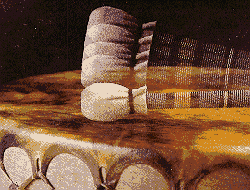
|
|
"Sacred noise gave
way to sacred music, and the result was an explosion of song." |
|
|
| |
|
|
 |
|
Since the dawn of civilization, our ancestors
understood and utilized the power of rhythm and sound to
connect with magic of "the sacred." An
elemental urge led early humans to summon the universal
god/goddess energies through ceremony and ritual, rhythmically
manipulating noise while simultaneously moving their bodies in
dance to the primal heartbeat of creation.
Gradually
developing skills as toolmakers, they discovered
the incredible sounds and rhythms that could be produced by
striking two bones, sticks or flints together, shaking a dried
pod, or creating a drum by stretching an animal skin over a
hollowed out section of a tree trunk and striking it with a
bone. "The sacred
was something we did, like hunting and procreating; the way we
approached it was through ritual.”
(Mickey Hart, p. 68) |
|
 |
|
|
|
| |
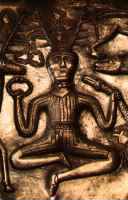
|
|
Archeologists discovered a site in the Ukraine
that seems to have been the working area of a Stone Age
percussionist: the sounds of
antiquity were scrapers
made out of mammoth jaws, beaters formed from reindeer antlers, and
a set of wrist rattles, one of bone and the other of seashells.
Even the caves themselves were used as resonating chambers.
The first evidence of shamanism, including both goddess
and god iconography, has been found in Cro-Magnon remains, app.
30,000 years old. It is
known that scrapers, rattles, and bone flutes were in use at that
time. |
|
|
| |
|
An anonymous artist in app. 15,000 B.C. painted
the earliest known picture of a musician/dancer on a wall. It
has been called the “dancing shaman of Les Trois Freres.” The
painting portrays a man in an animal skin and mask
playing some kind of instrument, possibly a sounding bow or
concussion stick, performing a dance as he prepares for the hunt. |
|
|
| |
|
It is believed that the
first drums appeared sometime between the Paleolithic and the
Neolithic periods (around 8,000 B.C.).
It was during the Neolithic period that towns appeared
for the first time. In
Catal Huyuk, best known of the Neolithic towns, the women performed
the rituals and ran the ceremonies while the men handled material
affairs. “There was an intimate relationship between the drum and
the goddess.” (Marija
Gimbutas) Percussion instruments were the primary force behind their
“audiovisual dance rituals,” in which the participants
experienced and felt the ceremony with all of their senses. |
|
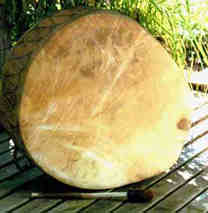 |
|
| |
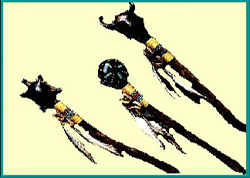 |
|
With the rise of the
Sumerian civilization and the dawn of agriculture, the sacred
shifted from the goddess to the worship of the sky gods.
Simultaneously, harps and horns were added to the traditional
clappers, rattles, flutes and drums to birth the era of sacred song.
Gradually the drum lost acceptance as a sacred
instrument. By the time
Christianity was adopted by the Roman Empire, the drum and cymbals
were banned as “mischievous”, “licentious,” and evidence of
“the devil’s pomposity.” |
|
|
| |
|
From this point on until
recent times, only the so-called “primitive,” indigenous peoples
maintained the sanctity and power of noise as expressed by the drum, balanced with chant
and dance, in their rituals and ceremonies. In so doing, they
kept alive the spirit, beauty and sacredness of the god/goddess
energies.
Today, as we seek to heal the wounds of Grandmother
Earth, civilization is looking back to its roots. We are realizing the necessity of balancing our
feminine-receptive (goddess) and masculine-expressive (god)
qualities within self and society.
In this process, we are rediscovering the ancient power of
sound in ceremony and ritual, reintegrating drum and dance with the beauty of
chant. It is with great respect and honor that we thank our
indigenous brothers and sisters for keeping alive the sacred
instruments, rhythms and voices of our ancestors. |
|
 |
|
| |
|
The Wild Rose Drum Team |
| |
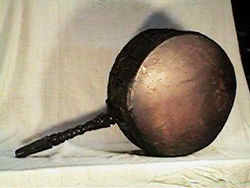
|
|
The Wild Rose Drum Team was founded in 1993 when
Lyn, following her passion and inner guidance, realized it was time
to chief her own team. Drawing
on ten years' experience as a Metis drum team member, including two
years as assistant drum chief, she now called on her Native
American and Celtic ancestors to assist her in this endeavor.
Following Metis guidelines, she invited interested friends and
acquaintances to join the team.
The response was incredible.
Soon there were fifteen people gathered together drumming and
chanting the spiritual rhythms and sounds of Shamanic cultures from
many paths, including Native American, Mayan, Celtic, East Indian
and Tibetan. The sacred
music of their collective ancestors transported the team into
wondrous arenas of beauty and transcendence. |
|
|
| |
| Within a year, the team had made its own
ceremonial drum. It is
an awesome and magical experience to create a drum out of
timber and skins. Calling upon a local Native American drum master to teach and
guide them, they gathered on a quiet spring day to build their drum
in sacredness and love. The
opening pipe ceremony set the tone for the day.
They called and felt the presence of the ancestors, the four
worlds (mineral, plant, animal and human), the elements (air, water,
fire and earth), the balance
of archetypal goddess and god energies, and the cohesiveness of their mutual
intent. They created a beautiful four-foot diameter drum that
would hold and honor their collective heartbeat in alignment with
the heartbeat of Grandmother Earth.
Just prior to tying the lacing, they placed tobacco ties
holding their individual prayers into the drum, and the ceremony was
complete. A sacred drum
was birthed, its spirit eager and alive. |
|
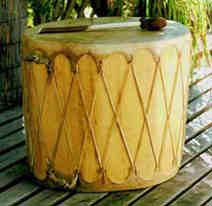 |
|
| |
|
Today, the Wild Rose Drum Team continues to meet
regularly, joining together hearts, voices and intent as they drum
and chant the magical music of the planet.
The members have discovered that their drum is a healer and teacher,
guiding them in the discovery of their own natural rhythms and
sounds that had so long been stilled by the values and ethos of
so-called "civilized" society. They now play
for Eagle Dances and other ceremonies, as well as just for
themselves, always aware of the sacred power and beauty of their
drum, always thanking Great Spirit for the opportunity to express
the sounds and rhythms that connect us with the heartbeat of our
indigenous human heritage.
For further information on "the spirit of
percussion," you
might be interested in checking out this book by Mickey Hart.

Copyright
1999 - 2022 All rights reserved
|
|
|

